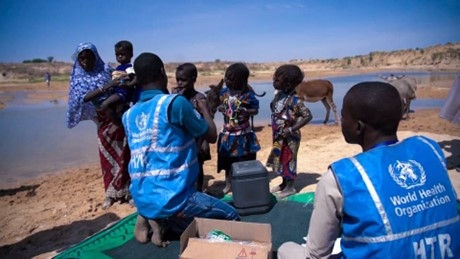As the global health community marks the 50th anniversary of the Expanded Programme on Immunization (EPI), established by the World Health Organization (WHO) in 1974, it is disconcerting to note that 14.3 million children in 2022 remained without the first crucial dose of diphtheria-tetanus-pertussis (DTP) vaccines.[1] These ‘zero dose’ children do not only face vulnerability to vaccine-preventable diseases, but they also lack access to basic health services. Furthermore, they are often exposed to determinants of good health and general well-being, such as poverty, conflict and the adverse effects of climate-related challenges. Access to immunization plays a direct role in influencing health outcomes and contributes to the achievement of 14 out of the 17 Sustainable Development Goals (SDGs).
Nigeria ranks first in the top 20 zero-dose countries list of 2022, with over 2.3 million estimated zero-dose children, about 16% of the global total.[2] The country also has the largest number of zero-dose children impacted by conflict. The Government of Nigeria has, rightly, prioritized reaching communities with a high burden of zero-dose children in its National Strategy for Immunization and Primary Health Care (PHC) System Strengthening (NSIPSS). The goal is to reduce the number of affected children by at least 80% by the end of 2028. [3]
A strategic priority goal of the World Health Assembly’s Immunization Agenda 2030 is to improve coverage and equity, thereby reducing the number of zero-dose children.[4] Recognizing that health-related complexities associated with zero-dose communities require cross-sectoral collaboration and strong partnerships, starting in 2020, the Ministry of Health (MoH), with support from WHO, used the multilateral collaboration platform, the Global Action Plan for Healthy Lives and Well-being for All (SDG3 GAP) to ensure a robust implementation of the NSIPSS, and specifically, to help identify and reach zero-dose communities with immunization services through the PHC system.[5] This aligns with Output 4.2.1 of the 2022-2023 WHO Programme Budget “Leadership, governance and external relations enhanced to implement GPW13 and drive impact in an aligned manner at country level.” Between March 2021 and January 2023, over six million children have benefitted from access to life-saving immunization services, with more than five million children receiving the third dose of pentavalent vaccine (Penta3) annually.
How did Nigeria, with the support WHO, achieve this?
High quality and fit-for-purpose data is essential to identify communities targeted for health interventions. In 2020, Nigeria’s National Primary Health Care Development Agency (NPHCDA) created a data system to locate zero-dose communities, with support from WHO and UNICEF.[6] Immunization records, health facilities, surveys, local community data at the sub-national level and other data sources were consolidated. Stakeholder workshops and meetings were organized to analyse the data, which indicated that targeting 100 local government areas (LGAs) in 18 states would reach 1.5 million zero-dose children out of the 2.3 million nationally and, improve immunization coverage. The detailed analysis informed revisions to the zero-dose priority actions within the NSIPSS.

WHO mobile health teams reaching eligible children in the Nomadic settings in Borno State Nigeria
Photo credit: WHO/Eromosele
WHO and partners’ purposeful collaborations behind national zero-dose priority actions sped up access to immunization services in targeted LGAs. WHO and UNICEF developed the Immunization Recovery Plan with the NPHCDA, which included the Big Catchup Plan targeting zero-dose children. Aligning with the plan, the World Bank partnered with 16 priority states to strengthen vaccine supply, cold chain equipment and monitoring systems to reduce the number of under-five deaths.[7] WHO, the Global Fund, UNICEF and other partners provided financial and technical assistance to 17 states to reach zero-dose communities in affected LGAs. In addition, the Gavi-HSS project, which earmarked USD 50 million of a PHC and immunization grant, complimented these efforts by supporting eight states to address low immunization coverage.
Expanding childhood vaccination coverage in Nigeria will require a substantial and sustained commitment to reach every zero-dose child and missed community. The Nigerian Government is committed to sustainably financing strong PHC as a key accelerator to achieve nation-wide immunization coverage, leaving no one behind. A state government accountability framework has been established with the aim to secure full Government funding for immunization and primary health care by 2028.
References
- WHO factsheet on Immunization coverage (18 July 2023).
- Progress and Challenges in Achieving Universal Immunization Coverage, 2022 WHO/UNICEF Estimates of National Immunization Coverage (WUENIC, 2 July 2023).
- Nigeria Strategy for Immunisation and PHC System Strengthening (NSIPSS, 2018-2028).
- Immunization Agenda 2030: A Global Strategy to Leave No One Behind (1 April 2020).
- The Global Action Plan for Healthy Lives and Well-being for All (SDG3 GAP), Stronger Collaboration, Better Health.
- SDG3 GAP Nigeria case study, Breaking barriers, building bridges: the collaborative effort to reach every child in Nigeria (30 August 2023).
- Nigeria - Immunization Plus and Malaria Progress by Accelerating Coverage and Transforming Services Project, World Bank (22 January 2020).
- UN Sustainable Development Cooperation Framework (UNSDCF, 2023-2027).

